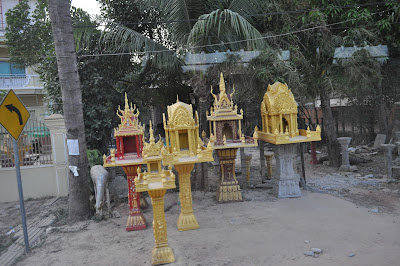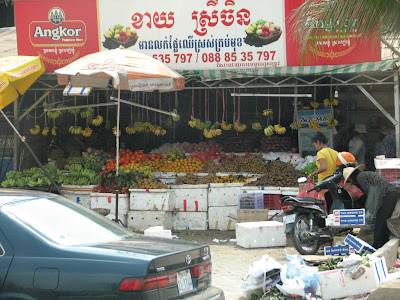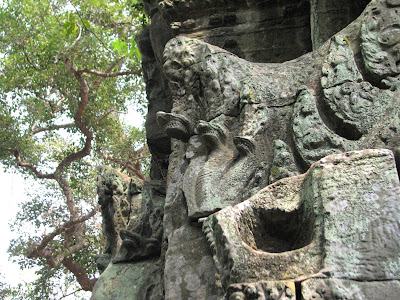We went swimming in the hotel pool, and were refreshed to head out again in the morning for more ruins! Because Angkor Wat faces west, they like to take you there in the afternoon so you won't have the sun behind it for your photos. We passed by interesting sights as we drove out to visit more ruins near Angkor Thom and Angkor Wat.
 |
| Shrines R Us |
Another outdoor shower for the kids. (Down below the road in the center.) Can you believe there are no guardrails on the ramp? Some of the ramps are just loose boards. And it doesn't look like the house can be supported by those small wooden posts. Scary. These are even worse living conditions than the townships I saw in South Africa.
 |
| Angkor School |
This is a "nicer" part of town on the other side of the bridge. The city is moving a lot of the "stilt" houses along the river out of town to clean up the image for the tourists.
 |
| Beautiful fruit market |
The Tuk Tuk drivers have a hammock to hang up in their vehicles so they can have a nap while they wait for the tourists to come back. Smart idea!
 |
| I have no idea what these things are, but I think you're supposed to eat them!! |
We stopped to explore the East Mebon Temple, dedicated in 953AD and built after the same style as the Pre Rup Temple. It stood on an artificial island in the center of the now dry East Baray Reservoir. It was dedicated to Shiva and built to honor King Rajendravarman's parents. I hope my kids build a temple in my honor someday.
I continue to be amazed that we are allowed to walk through all these ruins, especially when you see the condition of the remaining structures.
These harnessed elephants on the corners are free-standing, and taller than me! There are still about 1500 wild elephants in Cambodia. We didn't see any of those!
Interestingly enough, they call this specially-designed lower step the "moon stone". Sounds familiar.
 |
| This scene shows the god Indra atop his three-headed elephant Airavata. Very detailed! |
Did you see Tomb Raider? Parts of it were filmed in the amazing Ta Prohm Temple. We rented the movie after we got home, just to say "We've been there!"
Ta Prohm was built as a Mahayana Buddhist Monastery and University. King Jayavarman VII built it in honor of his parents in 1186AD, and the main image (Prajnaparamita--perfection of transcendent wisdom) is modeled after his mother.
Look how the front arch is almost falling off. They have done lots of restoration, but the jungle is trying to take over.
The temple site was home to more than 12,500 people (including 18 high priests and 615 dancers), with an additional 800,000 souls in the surrounding villages working to provide services and supplies. It was also recorded that the temple amassed considerable riches, including gold, pearls and silks. It's fun to imagine as we walked through the ruins.
 |
| Yes, those are roots of a tree! |
These amazing trees are why Ta Prohm is so famous. The trees have just "taken over" and the people on the restoration committees don't want to remove them because of the mystery and beauty they have created. It's almost as though the jungle has "swallowed" the temple. It's pretty incredible. And the trees are so young compared to the temple, but yet they are SO TALL! The roots are fantastic, climbing over the walls. It's unbelievable.
"Look, Ma. I made a temple with your face on it!"
 |
| Looks so unstable--but notice the beautiful carvings, still so wonderful. |
Our guide is in this photo. He was an amiable man with limited English language skills. He told us about their culture and of his arranged marriage. On his wedding day, when he first saw his bride, he said, "I thought she had so many muscles." But they are happy together.
There are two species of trees, but experts disagree on exactly what kind they are! Silk cotton and strangler fig are more commonly accepted.
 |
| See the smiling face in the roots of this tree? Amazing! |
Notice the serpents.
The "real-life lizard" on this rock added to the jungle feeling of the ruins. What a bright, red tail!
 |
| Awesome sculptures. |
The Citadel of Chambers, or Banteay Kdei, was a Buddhist Monastery built in the 12th century and is the same style as Ta Prohm. Although dilapidated because of faulty construction and poor quality sandstone, it has been inhabited off and on over the centuries by Buddhist monks, even as late as the 1960s. After the Khmer reign ended, it became overgrown with vegetation which was cleared away in the 1920s.
 |
| Look closely to see the buddhas in a row. |
This pretty lady is called Apsara. She's found all over these temples in different forms, many times in this "dancing" pose. She is a female spirit of the clouds and waters in Hindu and Buddhist mythology.
The top half of this large figure is called a Garuda, who is a Hindu bird, and beneath is a Naga, or dragon, who is a Buddhist figure. The country has gone back and forth between the two religions, so they try to keep everyone happy.
So much beauty and amazing architecture. And we haven't even seen the Granddaddy yet!




















































No comments:
Post a Comment